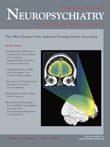Conversion Hemianesthesia: Possible Mechanism
To the Editor: A recent fMRI study of three patients who had a left-sided sensory conversion disorder found that unilateral vibrotactile stimulation of the affected limb did not produce activation of the contralateral primary somatosensory region. 1 Although these authors concluded that their findings implicated selective alterations in primary sensorimotor cortex, they did not posit an explanation for their findings.
Support for the observation that patients can fail to detect stimuli in the absence of defective afferent pathways comes from the observation of patients with attentional neglect. In the absence of injury the failure of the primary sensory cortex to activate could be induced by a reduced ability of the afferent signals to reach the cortex induced by closure of a physiological gate. Sensory information reaches the cortex after relay through specific thalamic nuclei and somatosensory information is transmitted via the ventralis posterolateralis. The thalamus is surrounded by the nucleus reticularis, which sends inhibitory projections to the thalamic relay nuclei, including the ventralis posterolateralis. Activation of the nucleus reticularis inhibits thalamic relay to the cortex. 2 The nucleus reticularis serves as a gate for sensory information. When a stimulus is significant or novel, corticofugal projections inhibit the nucleus reticularis and allow the thalamus to relay sensory input to the cortex. When a stimulus is not significant or novel, corticofugal projections to the nucleus reticularis can selectively excite the nucleus reticularis and inhibit the relay of sensory information.
Unimodal association areas converge upon polymodal or supramodal association cortex such as the prefrontal cortex and the posterior temporoparietal region. These posterior convergence areas may subserve cross-modal associations and sensory synthesis as well as store declarative memories or representations. Thus, these posterior temporoparietal areas are important in detecting novel and significant stimuli. These temporoparietal areas might project either directly or indirectly to the nucleus reticularis, and when there is a significant or novel stimulus the temporoparietal cortex might inhibit the inhibitory nucleus reticularis and allow more sensory information to the cortex. In contrast, the supramodal frontal cortex might be important in exciting the inhibitory nucleus reticularis and thus gate out information. Support for this postulate comes from the study of patients’ visual habituation using the Troxlar paradigm. 3 In this paradigm the subject looks at a central fixation point and notes when a lateral dot fades from vision. When these dots are presented contralateral to parietal lesions there was enhanced habituation (rapid fading), but when presented contralateral to frontal lesions there was delayed habituation.
Based on this cortical-nucleus reticularis gating hypothesis, patients with sensory conversion disorder should not only show reduced activation of their somatosensory cortex, but activation of their frontal cortex, which is responsible for activating the inhibitory nucleus reticularis. Some, but not all, functional imaging studies have demonstrated increased activation of the frontal cortex with sensory conversion disorder 4 and physiological studies demonstrate that the frontal cortex modulates activity of the nucleus reticularis. 5 However, further observations and tests of this gating hypothesis are necessary.
1 . Ghaffar O, Staines WR, Feinstein A: Unexplained neurologic symptoms: an fMRI study of sensory conversion disorder. Neurology 2006; 67:2036–2038Google Scholar
2 . Yingling CD, Skinner JE: Selective regulation of thalamic sensory relay nuclei by nucleus reticularis thalami. Electroencephalogr Clin Neurophysiol 1976; 41:476–482Google Scholar
3 . Mennemeier MS, Chatterjee A, Watson RT, et al: Contributions of the parietal and frontal lobes to sustained attention and habituation. Neuropsychologia 1994; 32:703–716Google Scholar
4 . Tiihonen J, Kuikka J, Viinamaki H, et al: Altered cerebral blood flow during hysterical paresthesia. Biol Psychiatry 1995; 37:134–137Google Scholar
5 . Yingling CD, Skinner JE: Regulation of unit activity in nucleus reticularis thalami by the mesencephalic reticular formation and the frontal granular cortex. Electroencephalogr Clin Neurophysiol 1975; 39:635–642Google Scholar



